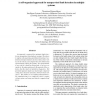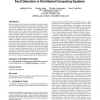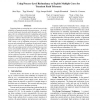24 search results - page 1 / 5 » A self-organized approach for unsupervised fault detection i... |
ICPR
2008
IEEE
13 years 11 months ago
2008
IEEE
An approach is proposed for automatic fault detection in a population of mechatronic systems. The idea is to employ self-organizing algorithms that produce lowdimensional represen...
SAC
2006
ACM
13 years 5 months ago
2006
ACM
Fast and accurate fault detection is becoming an essential component of management software for mission critical systems. A good fault detector makes possible to initiate repair a...
VLDB
2007
ACM
14 years 5 months ago
2007
ACM
Whenever an intrusion occurs, the security and value of a computer system is compromised. Network-based attacks make it difficult for legitimate users to access various network ser...
DSN
2007
IEEE
13 years 11 months ago
2007
IEEE
Transient faults are emerging as a critical concern in the reliability of general-purpose microprocessors. As architectural trends point towards multi-threaded multi-core designs,...
ICMCS
2006
IEEE
13 years 11 months ago
2006
IEEE
This paper addresses the problem of unsupervised speaker change detection. Three systems based on the Bayesian Information Criterion (BIC) are tested. The first system investigat...



